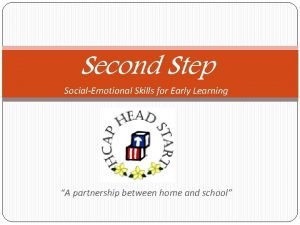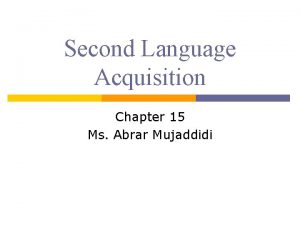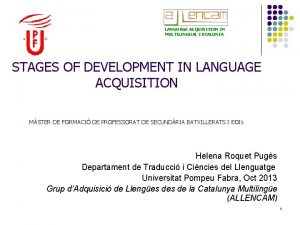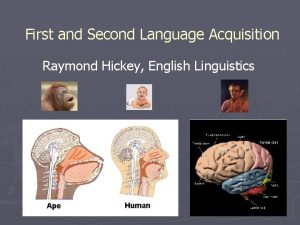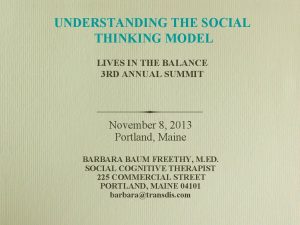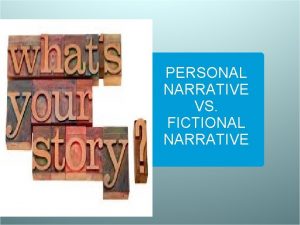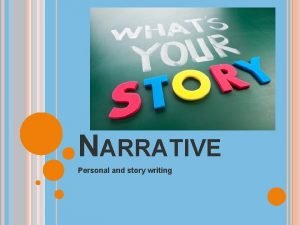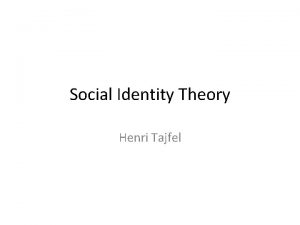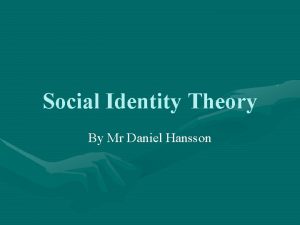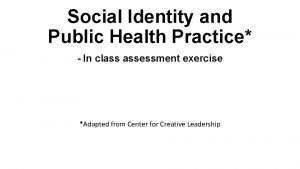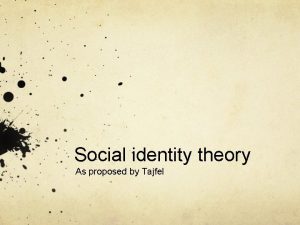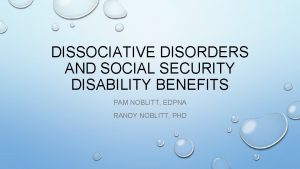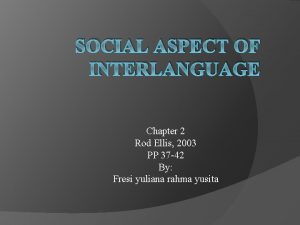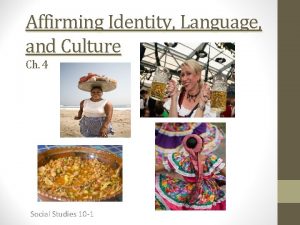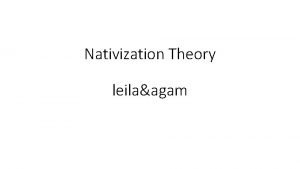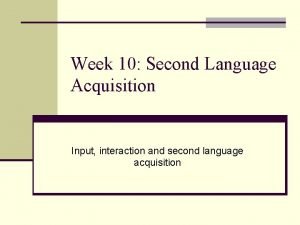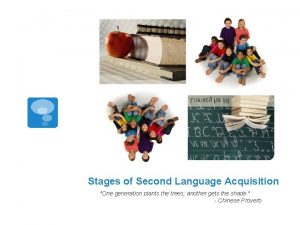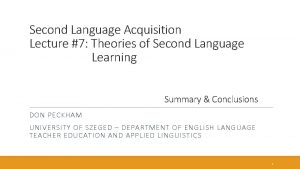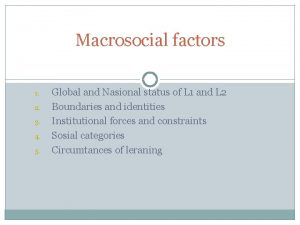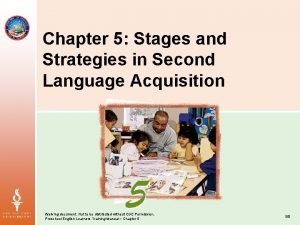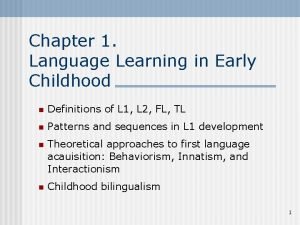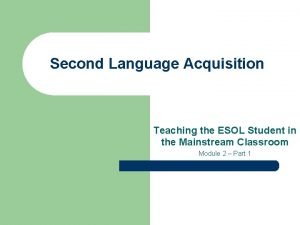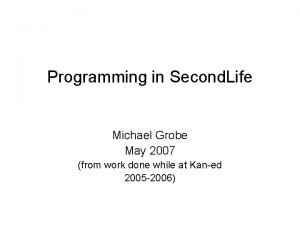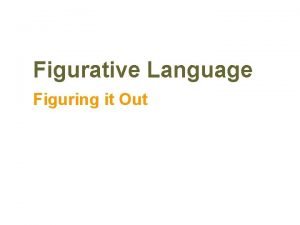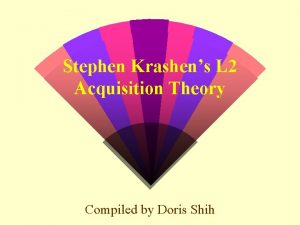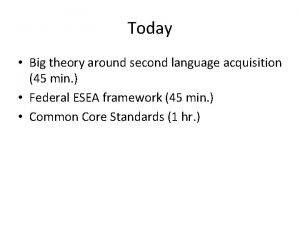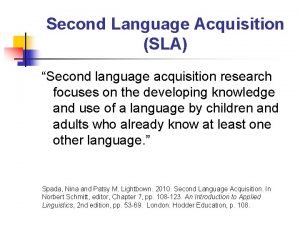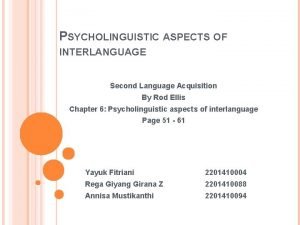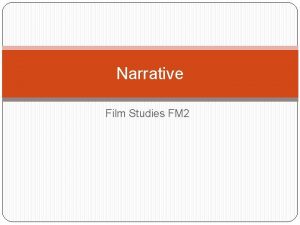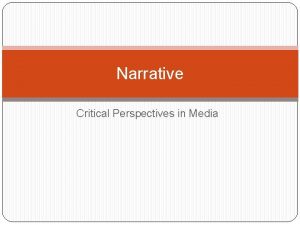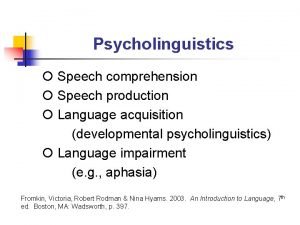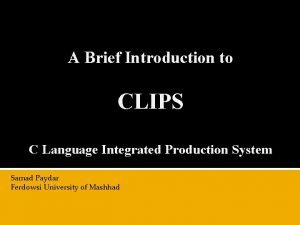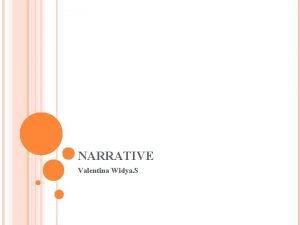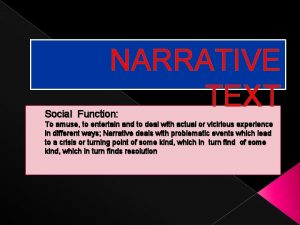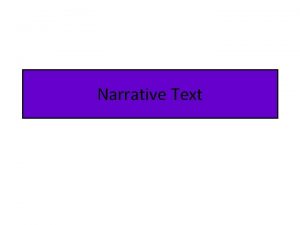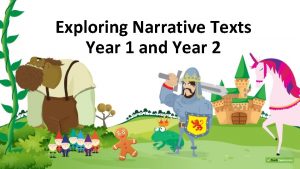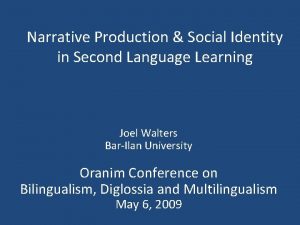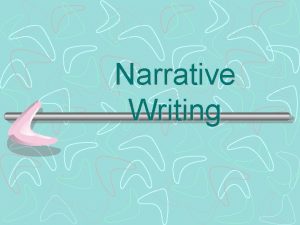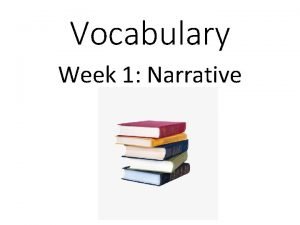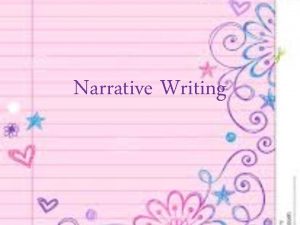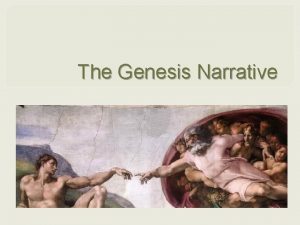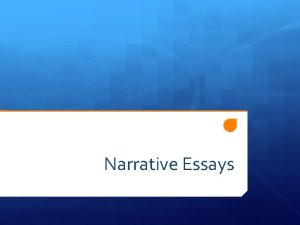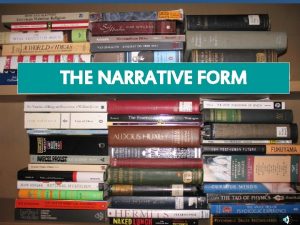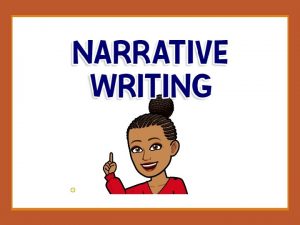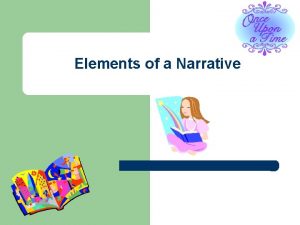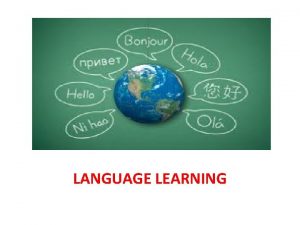Narrative Production Social Identity in Second Language Learning
































![Mf 509 (continued) *CHI: here's [: here are] [*] the slippers and she’s trying Mf 509 (continued) *CHI: here's [: here are] [*] the slippers and she’s trying](https://slidetodoc.com/presentation_image/a061ce5f2f92d10bef747bfcf9301085/image-33.jpg)


































- Slides: 67

Narrative Production & Social Identity in Second Language Learning Joel Walters Bar-Ilan University Oranim Conference on Bilingualism, Diglossia and Multilingualism May 6, 2009

Research Strategies Bilinguals vs. Monolinguals L 1 vs. L 2 Within Subject

Linguistic Models 1 Syntax-centered (Chomsky 1965, 1995) Phonology, Syntax, Semantics 2 Lexicon and Grammar (Ullman 2001, 2005) Declarative/Procedural Memory Temporal-Parietal/Frontal lobe, BA 44, BA 45

Acquisition/Bilinguals Acquisition Verb inflections, Prepositions, Definiteness, Lexis, Discourse Markers, Codeswitching, Code Interference Bilinguals Dominant/Weak language Children: Simultaneous, Sequential, Early, Late Adults: L 1 Arabic/Amharic/Hebrew/Spanish Atypical: Aphasics, Schizophrenics, SLI

Why study Narrative Production? • Multiple linguistic levels and multiple indicators in a single task: lexis, grammar, discourse, fluency • Grounds language in the social world and allows linguistic performance to be enveloped in pragmatics

WG 2 Israeli Narrative Studies • Lexis and Discourse in Preschool Narratives • Codeswitching in Bilingual Retelling • Autobiographical memory narratives among Amharic, English, Russian, Georgian and Hebrew Native Speakers • Health Narratives in Russian-Hebrew Schizophrenics • Children’s Holocaust Testimonies • Story Grammar Recall in Adult EFL learners

Overview of Talk I Story Grammar Recall in Adult EFL Learners II Lexis and Discourse in Preschool Narratives III Immigration narratives among Ethiopian College Students I

Four Approaches to Narrative • • Story Grammars (Stein & Glenn 1979) Labov on Narratives (1967, 1972, 1997) Text Construction (Ravid & Berman (2009) Systemic Functional (Martin & Rose 2008)

Stein & Glenn’s (1979) Story Grammar Setting: introduction of characters, time and place Initiating Event: event or action that sets up a problem or dilemma Internal Response/Goal: protagonist's reactions to the initiating event Attempt: An action or plan of the protagonist to solve the problem Consequence: result of protagonist's actions Ending: response by the protagonist to the consequence

Walters & Wolf (1986) EFL Story Recall Setting: Once there was a big gray fish named Albert, who lived in an icy pond at the edge of the forest. Initiating Event: One day Albert was swimming around and saw a fish near the surface of the pond. Internal Response: Albert loved worms and wanted to eat that one for his breakfast. Attempt(s): He swam toward the worm and bit into him. Consequence: Suddenly Albert was pulled into a boat. He had been caught by a fisherman. Ending: Albert was sorry and wished he had been more careful.

Story Grammar Categories in G 3 B Setting: Once upon a time there were three bears, a papa bear, a momma bear and a little tiny baby bear. They all lived in a tiny house in a great big forest. Initiating Event: One day a little girl named Goldilocks came walking through the forest. Internal Response/Goal: She was surprised to see the house and noticed it was empty. She was hungry and tired and wanted to rest. Attempt(s): Goldilocks went inside, tasted the three bowls of porridge, tried out the three chairs, and tried out the three beds. Consequence: The bears returned to find the porridge eaten, the baby chair broken and Goldilocks sleeping in the baby bear's bed. Ending: Goldilocks jumped out of the window and ran away.

Preschool Studies: Overall Design Language Pairs • English-Hebrew • Russian-Hebrew Stories • Familiar • Unfamiliar Tasks • Tell a story from memory • Tell a story from picture stimuli • Tell – retell from memory

Study I: Linguistic indicators Participants 8 SLI English-Hebrew bilinguals 9 TD English-Hebrew bilinguals Stories rendered Jungle Book (26) Goldilocks and the Three Bears (18) Languages English (24) Hebrew (24) Task: Tell story from picture stimuli

Study I: Linguistic measures Lexical indicators Morphosyntactic indicators Narrative indicators Fluency and intelligibility Experimenter influence Bilingual measures

Measures I: Lexical Indicators Utterances/Clauses Tokens Types Lexical Diversity: Type/token ratio Content words Semantic density: Content/token ratio Function words Verb-based utterances

Measures II Morphosyntactic and Syntactic Errors Verb Inflections omissions and substitutions Prepositions omissions and substitutions Articles omissions and substitutions Person, number, gender Complex syntax

Measures III: Narrative Structure SE IE GL IR AT CN EN Setting Initiating Event Goal Internal Response Attempt Consequence Ending

Measures IV: Fluency and Intelligibility Unintelligible utterances Irrelevant utterances Discourse markers – and, then, v’az, az

Measures V: Experimenter influence Experimenter utterances Experimenter tokens Child responses to a Yes-No Question Child responses to a Wh-question Repetitions of experimenter utterance Completions of experimenter utterances Unrelated to experimenter utterances

Measures VI: Bilingual Indicators Codeswitching (CS) *CHI: tinok’s bed *CHI: mexina soup *CHI: in the delet *CHI: and then they go madregot Code-interference (CI) *CHI: in the delet *CHI: someone ate from me. *CHI: she is trying the porridge here, it’s too hot, it's too hot, but now this [/] this one is warm for her and it’s [/] and it’s not hot.

Findings: Lexical indicators INDICATOR Number of utterances Tokens (words) Types (different words) EFFECTS GROUP * STORY * LANGUAGE GROUP Type/Token ratio GROUP * STORY * LANGUAGE GROUP Content words (freq) GROUP Semantic Density (content/token ratio) Percent Verb based utterances GROUP F Sig. 4. 32 . 044 33. 08 . 000 5. 66 . 022 11. 55 . 002 5. 82 . 020 23. 216 . 000 21. 20 . 000 3. 80 . 058 10. 58 . 002

Lexical indicators Verbosity: Frequency of tokens 300 250 200 eng heb 150 100 50 0 TD SLI Jungle Book TD SLI Goldilocks

Lexical indicators Type/Token Ratio & Semantic Density 0. 6 0. 5 0. 4 TD 0. 3 SLI 0. 2 0. 1 0 Type/Token ratio Semantic Density

Morphosyntax: Prepositions 0. 8 0. 7 0. 6 0. 5 TD 0. 4 SLI 0. 3 0. 2 0. 1 0 Omissions Substitutions

Narrative indicator: CONSEQUENCES 7 6 5 4 eng heb 3 2 1 0 TD SLI

Bilingual Measures: Codeswitching 3. 5 3 2. 5 2 Codeswitching 1. 5 1 0. 5 0 Eng Heb

Bilingual measures: Code Interference Group x Language Interaction 2. 5 2 1. 5 eng heb 1 0. 5 0 TD SLI


Bettelheim (1977) The Uses of Enchantment: The Meaning and Importance of Fairy Tales. New York: Vintage. Goldilocks and the Three Bears historical development (from Scottish oral folktale to written form in 1837) describes a strange story, since, unlike other fairy tales, it offers the children two equally good individuals to identify with, and thus, two equally strong readings.

Goldilocks and the Three Bears The story is about Identification Goldilocks is trying out different roles. However, there is no happy ending. Thus, even though she is especially attractive, and in need of a family, companionship or love, she remains alone: an excluded outsider

Identity Markers Two children (Mf 509, Am 506), before identifying with one of the characters, insert their “I”/ self identity very strongly and then identify with one of the characters and help that character ‘win. ’ A ‘safe’, even ideal, way to enter a story, to identify with a character, and to tell a meaningful story for the self is to first assert one’s own identity.

Mf 509 who identifies with Goldilocks *CHI: they’re making porridge and then they're going out. *CHI: xx and now Goldilocks is knocking on the door and she’s [//] nobody’s answering and she’s going in. *EXP: ok, let’s see what’s gonna happen. *CHI: she is trying the porridge here, it’s too hot, it's too hot, but now this [/] this one is warm for her and it’s [/] and it’s not hot. *EXP: ah, I see, so that one’s just right, yep, here she’s trying the porridge, yep, and then what about here? *CHI: he [/] here, she’s going into the room, here sh +. . . *EXP: uh hm.
![Mf 509 continued CHI heres here are the slippers and shes trying Mf 509 (continued) *CHI: here's [: here are] [*] the slippers and she’s trying](https://slidetodoc.com/presentation_image/a061ce5f2f92d10bef747bfcf9301085/image-33.jpg)
Mf 509 (continued) *CHI: here's [: here are] [*] the slippers and she’s trying [*] on and [/] and it’s not, um, comfortable for her +. . . *EXP: uh hm. *CHI: and this is not comfortable +. *EXP: uh hm. *CHI: but this is comfortable

Mf 509 invents an Ending: Bears invite G back “and then they want her to stay” *CHI: and everybody went to their chair xxx he saw the little girl xxx falling xxx and he was angry. *EXP: yeah, he was angry, so then did Goldilocks st +. . *CHI: she ran. *EXP: she ran away, yeah, right, is that the end, uh, the end. *CHI: and then +. . . %com: CHI reopens the story; ending does not fit her identification with Goldilock *EXP: hm? *CHI: and then they want her to stay. [[She only did damage; why did they want her to stay? she’s beautiful, lonely, needs food, love, out of her element; so CHI wants her to stay to fit in]]

Sibling rivalry The part of the story about the Baby Bear is about sibling rivalry. It is about intrusion and having one’s place in the family endangered. Am 506 identifies with the baby bear, and that is why he adds his evaluation at the end when he happily announces: “bye”, indicating that he is happy that Goldilocks, the intruder has left forever.

AM 506 *Am 506: me want to read this. *Am 506: me know this. *Am 506: three little bear. *Am 506: bears. [[focus is only on Little Bear, i. e. identifies with Baby Bear]] *Am 506: daddy. *Am 506: mommy. *Am 506: the baby. [[definite article shows his identification; only use of def article is here]] *Am 506: one day… *Am 506: aba, ima. *Am 506: xxx bear. *AKI: mitot. *AKI: yeah. *AKI: mommy. *AKI: tinok’s bed.

*Am 506 : *Am 506: *Am 506: *Am 506: *Am 506: AM 506 (continued) xxx oxel. mexina soup. no, a porridge. hot. went … a walk. Goldilocks. tuk. in the delet. no! came inside. and she sat kise. xxx. porridge.

AM 506 (continued) *Am 506: *Am 506: *Am 506: xxx mi- po. to the bedroom. this… to the house. xxx you should eat my porridge. // and then they go madregot. ha-tinok amar. xxx sleeping in my bed. yeah. run here. bye.

Df 608/No identification *CHI: yeah, I have it in my house, Goldilocks+And+The+Three+Bears. [[sets up for strong identification, but doesn’t follow through]] *EFR: once upon a time. *CHI: there was *EFR: there were three *CHI: bears, they went out *EFR: they had three. *CHI: chairs *EFR: and *CHI: three beds. *EFR: yes, one day. *CHI: Mommy baked xxx. *EFR: yeah.

Study II: Codeswitching in Bilingual Story Retelling Research Question To what extent do language impairment, story content and task influence the frequency and direction of codeswitching? Participants 4 Eng-Heb bilinguals diagnosed as LI in both languages 9 TD English-Hebrew bilinguals Stories and Task Hebrew story retold to an English-speaking puppet English story retold to a Hebrew-speaking puppet Codeswitched story retold to a bilingual puppet Measures Frequency of CS Directionality of CS

Stimulus Stories Hebrew English Mixed Setting Once upon a time there was a girl named Tal. She went to Gan Ronit. She liked Dana from gan very much. Once upon a time there was a boy named David. He lived in Tel-Aviv. He liked his father very much. Once upon a time there was a boy named Ron. He came from England. His parents knew very little Hebrew. Initiating event I One day they went to xacer to play, and each wanted to play a different game. Tal wanted to build a palace from sand, but Dana didn't want to do that. One evening he came to the kitchen to eat, and he found a big plate with soup and hotdogs. David wanted to eat a hamburger and French fries with ketchup, but his mom didn't want him to eat that. One morning he woke up with a sore throat, and his mom took him to the doctor. The doctor wanted to know what happened, but Ron's mom didn't want to speak Hebrew. Internal Response Tal was angry because Dana didn't like her game. David felt sad because Ron felt embarrassed his mom didn’t want to because his mom make his favorite food. didn’t know Hebrew.

Stimulus Stories Hebrew English Mixed Initiating event II She shouted at Dana: "I don't want to be your friend! You never listen to me". He shouted at his mom: "I don't want to eat soup and hotdogs. You never give me the food I like". He shouted at his mom: "I don't want to go anywhere with you. You can’t ever say anything in Hebrew". Consequence I And Dana answered: "I'll play with another girl because you’re meacbenet". Consequece II Ending And his mom answered: "First eat your soup and hotdogs because I already made it". Tal was shouting so David was shouting so loudly that the loudly that his mom ganenet told her she told him he would not sit in the play with his Lego, and mifgash, and that she would tell his would tell her parents. father. And his mom answered: "You teach me Hebrew because I don’t know a lot of words". Ron was shouting so loudly that the doctor told him to apologize to his mother and to leave the office.

Findings 2. 8 2. 7 2. 6 2. 5 SLI 2. 4 TD 2. 3 2. 2 2. 1 CS to L 2

Language Choice in the Bilingual story

Story told in English(L 1), retold in Hebrew (L 2) NMSLI 01 *CHI: David gar ah at tel-aviv…david gar ba-tel-aviv ve ve-yesh lo aba, ve-yesh lo soup ve ve vehotdogs. He wants eh hamburgers and snichel ve-qetchop. Ima amar eh shouted out …she shouted you are not gonna play with lego and you call his father. *EXP: ata yaxol lesaper le-dudidu ma yiqre axar~kax? *CHI: he he he shouted so much and he will not play with his lego and he'll call his father.

NMSLI 01 (continued) *EXP: *CHI: shelo. *EXP: *CHI: 'erev? halax aval ani roca she-tesaper le-dudidu axar~kax ma yiqre. 'axshav hi hi ima shelo shouted and hi loh natan lo lesaxeq 'im ha-logo 'im lego ve ve-hi amar aba ken. Aval axar~kax ma yiqre 'im aruxat hahe he yilex habayta. Ze ma she-hu

Story told in Hebrew (L 2), retold in English (L 1) NMTD 02 *CHI: pa'am axat… eh once there was tal and dana. Eh they were friends. Outside they played with sand, and tal wanted to build a castle and she and dana didn't want to… *EXP: so what happened then? *CHI: tal said she said I don’t understand, she didn't listen to her. *EXP: and dana. *CHI: and dana said she will play with a different friend, that she is…ani loh yodea ex omrim lehaskim be-anglit. *EXP: ok.

NMTD 02 (continued) *CHI: *EXP: *CHI: ve then the ganenet said that she will tell it ti her ima and aba and then she said she wouldn't be in the mifgash. very good. Now what do you think would happen next in this story? Can you tell jane? eh, loh yodea' think what would happen after the teacher shouted at her? she'll tell ima and aba. , and she won' sit in the mifgash.

Labov on Narratives I/2 Temporal organization 3 Structural components 4 Evaluation 5 Reportability 6 Credibility 7 Causality 8 Assignment of praise and blame 9 Viewpoint 10 Objectivity 11 Resolution

Labov 3 : Structural Components Abstract - initial clause in a narrative that reports the entire sequence of events of the narrative Orientation clause - information on the time, place of the events of a narrative, the identities of the participants and their initial behavior Complicating action - a sequential clause that reports a next event in response to a potential question, "And what happened [then]? " Resolution/Coda - a final clause which returns the narrative to the time of speaking, precluding a potential question, "And what happened then? “

Labov 3 : Functional Components Evaluation Reportability Credibility Causality Praise and blame Viewpoint Objectivity

Limitations • • Bilingual SLI children are ‘handy samples’ from ‘language preschools’ in one town in Israel Number of experimenters led to variability in data collection procedures

Next Steps • • Further analyses of current data More rigorous design Additional bilingual pairs Narrative vs. Interactive tasks

Acknowledgements ISRAEL SCIENCE FOUNDATION BMBF (GERMAN MINISTRY OF EDUCATION) Sharon Armon-Lotem Natalia Gagarina Efrat Harel Rita Horvath Peri Iluz-Cohen Natalia Meir Miri Yochanna Sveta Fichman Carmit Altman Ido Liberman Yisrael Smith

Labov 4 a: Evaluation (4. 1) Definition: Evaluation of a narrative event is information on the consequences of the event for human needs and desires. (4. 2) Definition: An evaluative clause provides evaluation of a narrative event. Linguistic structures serving evaluative function: emphasis, parallel structures, comparatives; Most important: modals, negatives and futures

Labov 4 b: Evaluation Irrealis Clauses (4. 3) Hypothesis 1: A narrative clause in an irrealis mood is an evaluative clause. (4. 4) L&W Theorem 1: A narrator evaluates events by comparing them with events in an alternative reality that was not in fact realized. Irrealis clauses—negatives, conditionals, futures — refer to events that did not happen or might have happened or had not yet happened Frequency of irrealis clauses in narrative increases rapidly with age, as speakers gain the ability to evaluate their experience (Labov 1972)

Labov 5: Reportability (5. 2) Definition: A reportable event is one which justifies the automatic reassignment of speaker role to the narrator. (5. 2. 1) Implication: To be an acceptable social act, a narrative of personal experience must contain at least one reportable event. (5. 3) Definition: A most reportable event is the event that is less common than any other in the narrative and has the greatest effect upon the needs and desires of the participants in the narrative.

Labov 6 a: Credibility (6. 1) The credibility of a narrative is the extent to which listeners believe that the events described actually occurred in the form described by the narrator. Remembering that the reportability of an event is related to its frequency, as well as its effects upon the needs and desires of the actors, it follows almost automatically that as reportability increases, credibility decreases.

Labov 6 b: Credibility (6. 2) Reportability Paradox: Reportability is inversely correlated with credibility. (6. 3) Theorem: A serious narrative which fails to achieve credibility is considered to have failed, and the narrators claim to re-assignment of speakership will then be seen as invalid. An "invalid claim to re-assignment" = narrator has suffered a loss of status (6. 3. 1) Implication: The more reportable the events of a narrative, the more effort the narrator must devote to establishing credibility.

Labov 7 a: Causality (7. 1) Theorem: Narrative construction requires a personal theory of causality. 1. The narrator first selects a most reportable event e₀, which the narrative is going to be about. 2. The narrator then selects a prior event e₋₁ which is the efficient cause of e₀, that is, answers the question about e₀, "How did that happen? " 3. The narrator continues the process of step 2, recursively, until an event e⁻ⁿ is reached for which the question of step 2 is not appropriate.

Labov 7 b: Causality There are many intricate and difficult issues in the reduction of a narrative statement to a causal one, and undoubtedly there will be wide variations in such acts of interpretation. The essential construction is that there is a proposed chain of events linking the orientation to the most reportable event. It will turn out eventually that the selection of the Orientation is a crucial act of interpretation of the stream of events, and a necessary step in the next aspect of narrative, the assignment of praise and blame.

Labov 8 a: Praise and Blame In accounts of conflict between human actors, or the struggle of human actors against natural forces, the narrator and the audience inevitably assign praise and blame to the actors for the actions involved. The ways in which this is done include the use of linguistic devices of mood, factivity and causativity, evaluative lexicon, the insertion of "pseudo-events, “ and the wholesale omission of events.

Labov 8 a: Praise and Blame Polarizing narrative, where the antagonist is viewed as maximally violating social norms, and the protagonist maximally conforming to them Integrating narrative, where blame is set aside or passed over by a variety of devices. Assignment of praise or blame certainly reflects the point of view of the narrator, colored by his/her moral stance. But it is not usually a conscious part of the information conveyed by the narrator to the audience; it is rather the ideological framework within which events are viewed.

Labov 9: Viewpoint (9. 1) The viewpoint of a narrative clause is the spatiotemporal domain from which the information conveyed by the clause could be obtained by an observer. In oral narratives of personal experience, the events are seen through the eyes of the narrator. (9. 2) Finding: The viewpoint in oral narratives of personal experience is that of the narrator at the time of the events referred to. (9. 2. 1) Implication: The temporal sequence of events in oral narratives of personal experience follows the order in which the events became known to the narrator. (9. 2. 2) Finding: There are no flashbacks in oral narratives of personal experience.

Labov 10: Objectivity (10. 1) An objective event is one that became known to the narrator through sense experience. A subjective event is one that the narrator became aware of through memory, emotional reaction or internal sensation. (10. 2) Since it is generally agreed that the narrators' observations can be affected by their internal states, reports of objective events are more credible than reports of subjective events. (10. 3) The transfer of experience of an event to listeners occurs to the extent that they become aware of it as if it were their own experience. (10. 3. 1) Implication: The transfer of experience from narrator to audience is limited, since the verbal account gives only a small fraction of the information that the narrator received through sight, sound and other senses (10. 3. 2) Implication: To the extent that narrators add subjective reports of their emotions to the description of an objective event, listeners become aware of that event as if it were the narrator's experience. (10. 3. 3). Theorem: The objectivity of the description of an event is a necessary condition for the transfer of experience in personal narrative.

Labov 11: Resolution The resolution can be seen to be logically the series of complicating actions that follow rather than precede. (11. 1) Definition: The resolution of a personal narrative is the set of complicating actions that follow the most reportable event.

Labov 11: Resolution narrative as a technique of reporting past events through temporal juncture, understanding of the temporal organization and evaluation of narrative. the concept of reportability, arguing that the most reportable event is the semantic and structural pivot on which the narrative is organized. • Given an initial inverse relation between credibility and reportability, it follows that narrators who command the attention and interest of their audience will normally maximize credibility by the objective reporting of events. • The second half focuses on the capacity of a narrative to transfer the experience of the narrator to the audience. Transfer of experience of an event to listeners occurs to the extent that they become aware of it as if it were their own experience. It follows that this is only possible if the narrator reports events as objective experience without reference to the narrator's emotional reactions. • A narrative can be viewed as a theory of the causes of the most reportable event, so that the crucial interpretive act is the location of the orientation as the situation that does not require an explicit cause. The chain of causal events selected in the narrative is intimately linked with the assignment of praise and blame for the actions reported. This view of narrative as a • theory of moral behavior and the • narrator as an exponent of cultural norms • will be pursued in later publications. • • •
 Alir proses produksi multimedia
Alir proses produksi multimedia Second step social emotional skills for early learning
Second step social emotional skills for early learning Individual differences in second language learning
Individual differences in second language learning Second language vs foreign language
Second language vs foreign language Difference between second language and foreign language
Difference between second language and foreign language Difference of first language and second language
Difference of first language and second language Difference of first language and second language
Difference of first language and second language Social identity mapping
Social identity mapping 186 282 miles per second into meters per second
186 282 miles per second into meters per second Cuadro comparativo e-learning b-learning m-learning
Cuadro comparativo e-learning b-learning m-learning Social thinking tree
Social thinking tree Social thinking and social influence in psychology
Social thinking and social influence in psychology Social thinking social influence social relations
Social thinking social influence social relations Language learning with youtube
Language learning with youtube Fictional narrative stories
Fictional narrative stories Difference between narrative and story
Difference between narrative and story Social language vs academic language
Social language vs academic language Henri tajfel theory
Henri tajfel theory Social identity
Social identity Given chosen and core identity
Given chosen and core identity Social identity theory tajfel
Social identity theory tajfel Social identity pie chart
Social identity pie chart Dissociative identity disorder social security disability
Dissociative identity disorder social security disability Stylistic continuum in interlanguage
Stylistic continuum in interlanguage Stylistic continuum in interlanguage
Stylistic continuum in interlanguage Social identity complexity
Social identity complexity Cultural affirmation definition social studies
Cultural affirmation definition social studies Social class identity
Social class identity Denativization
Denativization Vce chinese second language study design
Vce chinese second language study design Input and interaction in second language acquisition
Input and interaction in second language acquisition Slidetodoc.com
Slidetodoc.com Stages of language development
Stages of language development 7 theories of second language acquisition
7 theories of second language acquisition Second language definition
Second language definition Macro social factors
Macro social factors English as a second language igcse syllabus
English as a second language igcse syllabus Sequences of development
Sequences of development Chapter 5 stage 2 vergeway
Chapter 5 stage 2 vergeway Second language definition
Second language definition роберт ладо
роберт ладо Cummins model of second language acquisition
Cummins model of second language acquisition Second life programming language
Second life programming language Can i have one of your chips figurative language
Can i have one of your chips figurative language Contrasting acquisition
Contrasting acquisition The natural order
The natural order Second language
Second language Second language acquisition
Second language acquisition Sla theory
Sla theory Psycholinguistic approach to second language acquisition
Psycholinguistic approach to second language acquisition Learning narrative essay
Learning narrative essay Narrative learning intentions
Narrative learning intentions Narrative writing learning intentions
Narrative writing learning intentions Speech errors examples
Speech errors examples Language comprehension in psycholinguistics
Language comprehension in psycholinguistics Pre production language acquisition stage
Pre production language acquisition stage C language integrated production system
C language integrated production system Summary recording in social case work
Summary recording in social case work What is the social function of the story
What is the social function of the story What is the social function of narative text
What is the social function of narative text What is the main purpose of a narrative?
What is the main purpose of a narrative? Language features of a narrative
Language features of a narrative Lda supervised or unsupervised
Lda supervised or unsupervised Concept learning task in machine learning
Concept learning task in machine learning Analytical learning in machine learning
Analytical learning in machine learning Example of non associative learning
Example of non associative learning Eager learning
Eager learning Conceptual learning definition
Conceptual learning definition

